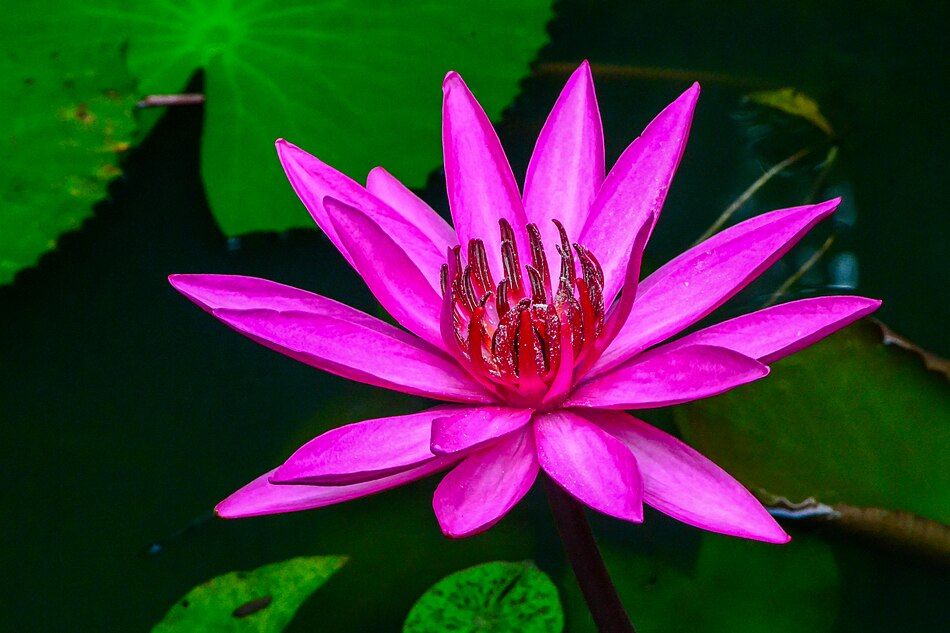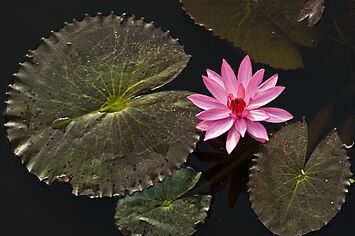Nymphaea subg. Lotos
| Nymphaea subg. Lotos | |
|---|---|

| |
| Botanical illustration of Nymphaea lotus | |
| Scientific classification | |
| Kingdom: | Plantae |
| Clade: | Tracheophytes |
| Clade: | Angiosperms |
| Order: | Nymphaeales |
| Family: | Nymphaeaceae |
| Genus: | Nymphaea |
| Subgenus: | Nymphaea subg. Lotos |
| Type species | |
| Nymphaea lotus L.[1][2] | |
| Species | |
|
See here | |
Nymphaea subg. Lotos is a subgenus of the genus Nymphaea.[3][2]
Description
[edit]Vegetative characteristics
[edit]The rhizomes are short, vertical, and tuberous. The leaves have a dentate margin.[2]
Generative characteristics
[edit]The emergent flowers are nocturnal or diurnal. The stamens do not have sterile appendages at the apex.[2]
Taxonomy
[edit]Publication
[edit]It was published as Nymphaea sect. Lotos DC. by Augustin Pyramus de Candolle in 1821. Later, it was elevated to the subgenus Nymphaea subgen. Lotos (DC.) Conard published by Henry Shoemaker Conard in 1905.[3][1]
Type species
[edit]The type species is Nymphaea lotus L.[2]
Species
[edit]- †Nymphaea brongniartii (Caspary) Saporta[4]
- Nymphaea lotus L.
- Nymphaea pubescens Willd.
- Nymphaea rubra Roxb. ex Andrews
Fossil record
[edit]Fossils from the upper Oligocene (28.4–23.0 million years ago) of France have been assigned to Nymphaea subg. Lotos.[4]
Distribution
[edit]It is native to the paleotropis.[2]
Ecology
[edit]Pollination
[edit]Beetle pollination by Ruteloryctes morio has been reported in Nymphaea subg. Lotos.[5][6][7]
References
[edit]- ^ a b Nymphaea sect. Lotos | International Plant Names Index. (n.d.). Retrieved January 23, 2024, from https://www.ipni.org/n/77303556-1
- ^ a b c d e f null. Nymphaea subg. Lotos, in (ed.), Flora of Australia. Australian Biological Resources Study, Department of Climate Change, Energy, the Environment and Water: Canberra. https://profiles.ala.org.au/opus/foa/profile/Nymphaea%20subg.%20Lotos [Date Accessed: 24 January 2024]
- ^ a b Nymphaea subgen. Lotos | International Plant Names Index. (n.d.). Retrieved January 23, 2024, from https://www.ipni.org/n/77303970-1
- ^ a b Butzmann, R., & Fischer, T. C. (2013). "Fossil water lily fruits with seeds Nymphaea subgenus Lotos, from the Oligocene of Armissan/Narbonne (France)." Zitteliana, 93-104.
- ^ Hirthe, G., & Porembski, S. (2003). Pollination of Nymphaea lotus (Nymphaeaceae) by rhinoceros beetles and bees in the northeastern Ivory Coast. Plant Biology, 5(06), 670-676.
- ^ Ervik, F., & Knudsen, J. T. (2003). Water lilies and scarabs: faithful partners for 100 million years?. Biological Journal of the Linnean Society, 80(3), 539-543.
- ^ Krell, F. T., Hirthe, G., Seine, R., & Porembski, S. (2003). Rhinoceros beetles pollinate water lilies in Africa (Coleoptera: Scarabaeidae: Dynastinae; Magnoliidae: Nymphaeaceae). Ecotropica, 9(1/2), 103-106.


